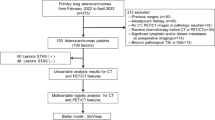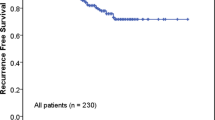Abstract
Objective
Lung adenosquamous carcinoma (ASC) is a rare histological subtype of non-small cell lung cancer (NSCLC). Due to its rarity, the studies about 18F-FDG PET/CT in this kind of pulmonary tumor were quite limited. Thus, this study investigated 18F-FDG PET/CT findings in ASC and its correlation with clinicopathological features and clinical outcomes.
Methods
Preoperative 18F-FDG PET/CT findings and parameters of maximum standard uptake value (SUVmax), metabolic tumor volume and total lesion glycolysis of primary lesion (MTV-P, TLG-P), combination of primary lesion and metastases (MTV-C, TLG-C), and clinicopathological features were retrospectively investigated in patients with ASC. Moreover, progression-free survival (PFS) was also analyzed.
Results
All 41 patients (25 men; 16 women; age: 60 ± 7 years) had single ASC with the mean diameter of 33 ± 14 mm. Six lesions were located centrally and 35 peripherally. Serum tumor markers were abnormally increased sporadically. Twenty-two cases were at TNM stage I, 9 at II, and 10 at III. The primary tumors were FDG-avid in all cases, with the average SUVmax of 11.5 ± 6.0. SUVmax was significantly associated with tumor location, size, and TNM stage (P < 0.05). Forty-one lesions were subgrouped into 23 AC-predominant and 18 SCC-predominant lesions, and significant differences were observed for age, tumor size, and SUVmax in two groups (P < 0.05). The median PFS of 41 cases was 19 months, and 12-month and 24-month PFS rates were 72.1% and 36.1%, respectively. SUVmax, MTV-P, and TLG-C were significantly associated with PFS (P < 0.05).
Conclusions
ASC of the lung displayed high SUVmax on 18F-FDG PET/CT, which was associated with tumor location, size, TNM stage, and predominant histologic component. Moreover, metabolic parameters of 18F-FDG PET/CT were independent prognostic factors of this rare lung malignancy.





Similar content being viewed by others
References
Travis WD, Travis LB, Devesa SS. Lung cancer. Cancer. 1995;75(1Suppl):191–202.
Sawabata N, Asamura H, Goya T, Mori M, Nakanishi Y, Eguchi K, et al. Japanese lung cancer registry study: first prospective enrollment of a large number of surgical and nonsurgical cases in 2002. J Thorac Oncol. 2010;5:1369–75.
Travis WD, Brambilla E, Burke AP, Marx A, Nicholson AG. Introduction to The 2015 World Health organization classification of tumors of the lung, pleura, thymus, and heart. J Thorac Oncol. 2015;10(9):1240–2.
Takamori S, Noguchi M, Morinaga S, Goya T, Tsugane S, Kakegawa T, et al. Clinicopathologic characteristics of adenosquamous carcinoma of the lung. Cancer. 1991;67(3):649–54.
Nakagawa K, Yasumitu T, Fukuhara K, Shiono H, Kikui M. Poor prognosis after lung resection for patients with adenosquamous carcinoma of the lung. Ann Thorac Surg. 2003;75(6):1740–4.
Cooke DT, Nguyen DV, Yang Y, Chen SL, Yu C, Calhoun RF. Survival comparison of adenosquamous, squamous cell, and adenocarcinoma of the lung after lobectomy. Ann Thorac Surg. 2010;90(3):943–8.
Filosso PL, Ruffini E, Asioli S, Giobbe R, Macri L, Bruna MC, et al. Adenosquamous lung carcinomas: a histologic subtype with poor prognosis. Lung Cancer. 2011;74(1):25–9.
Watanabe Y, Tsuta K, Kusumoto M, Yoshida A, Suzuki K, Asamura H, et al. Clinicopathologic features and computed tomographic findings of 52 surgically resected adenosquamous carcinomas of the lung. Ann Thorac Surg. 2014;97(1):245–51.
Lu P, Yu L, Li Y, Sun Y. A correlation study between maximum standardized uptake values and pathology and clinical staging in nonsmall cell lung cancer. Nucl Med Commun. 2010;31(7):646–51.
Li M, Sun Y, Liu Y, Han A, Zhao S, Ma L, et al. Relationship between primary lesion FDG uptake and clinical stage at PET-CT for non-small cell lung cancer patients: An observation. Lung Cancer. 2010;68(3):394–7.
Zhang H, Wroblewski K, Liao S, Kampalath R, Penney BC, Zhang Y, et al. Prognostic value of metabolic tumor burden from (18)F-FDG PET in surgical patients with non-small-cell lung cancer. Acad Radiol. 2013;20(1):32–40.
Takeuchi S, Khiewvan B, Fox PS, Swisher SG, Rohren EM, Bassett RL Jr, et al. Impact of initial PET/CT staging in terms of clinical stage, management plan, and prognosis in 592 patients with non-small-cell lung cancer. Eur J Nucl Med Mol Imaging. 2014;41(5):906–14.
Lee Y, Chung JH, Kim SE, Kim TJ, Lee KW. Adenosquamous carcinoma of the lung: CT, FDG PET, and clinicopathologic findings. Clin Nucl Med. 2014;39(2):107–12.
Ito R, Iwano S, Kishimoto M, Ito S, Kato K, Naganawa S. Correlation between FDG-PET/CT findings and solid type non-small cell cancer prognostic factors: are there differences between adenocarcinoma and squamous cell carcinoma? Ann Nucl Med. 2015;29(10):897–905.
Wu X, Huang Y, Li Y, Wang Q, Wang H, Jiang L. (18)F-FDG PET/CT imaging in pulmonary sarcomatoid carcinoma and correlation with clinical and genetic findings. Ann Nucl Med. 2019;33(9):647–56.
Uramoto H, Yamada S, Hanagiri T. Clinicopathological characteristics of resected adenosquamous cell carcinoma of the lung: risk of coexistent double cancer. J Cardiothorac Surg. 2010;5:92.
Maeda H, Matsumura A, Kawabata T, Suito T, Kawashima O, Watanabe T, et al. Adenosquamous carcinoma of the lung: surgical results as compared with squamous cell and adenocarcinoma cases. Eur J Cardiothorac Surg. 2012;41(2):357–61.
Yu JQ, Yang ZG, Austin JH, Guo YK, Zhang SF. Adenosquamous carcinoma of the lung: CT-pathological correlation. Clin Radiol. 2005;60(3):364–9.
Ishida T, Kaneko S, Yokoyama H, Inoue T, Sugio K, Sugimachi K. Adenosquamous carcinoma of the lung Clinicopathologic and immunohistochemical features. Am J Clin Pathol. 1992;97(5):678–85.
Kazerooni EA, Bhalla M, Shepard JA, McLoud TC. Adenosquamous carcinoma of the lung: radiologic appearance. AJR Am J Roentgenol. 1994;163(2):301–6.
Zhi Q, Wang Y, Wang X, Yue D, Li K, Jiang R. Predictive and prognostic value of preoperative serum tumor markers in resectable adenosqamous lung carcinoma. Oncotarget. 2016;7(40):64798–809.
Jin X, Xu X, Xu H, Lv L, Lu H. The Diagnostic Value of Carcinoembryonic Antigen and Squamous Cell Carcinoma Antigen in Lung Adenosquamous Carcinoma. Clin Lab. 2017;63(4):801–8.
Foa P, Fornier M, Miceli R, Seregni E, Santambrogio L, Nosotti M, et al. Tumour markers CEA, NSE, SCC, TPA and CYFRA 21.1 in resectable non-small cell lung cancer. Anticancer Res. 1999;19(4):3613–8.
Iwano S, Kishimoto M, Ito S, Kato K, Ito R, Naganawa S. Prediction of pathologic prognostic factors in patients with lung adenocarcinomas: comparison of thin-section computed tomography and positron emission tomography/computed tomography. Cancer Imaging. 2014;14:3.
Fu L, Alam MS, Ren Y, Guan W, Wu H, Wang Q, et al. Utility of Maximum standard uptake value as a predictor for differentiating the invasiveness of T1 stage pulmonary adenocarcinoma. Clin Lung Cancer. 2018;19(3):221–9.
Eriguchi D, Shimada Y, Imai K, Furumoto H, Okano T, Masuno R, et al. Predictive accuracy of lepidic growth subtypes in early-stage adenocarcinoma of the lung by quantitative CT histogram and FDG-PET. Lung Cancer. 2018;125:14–211.
Kishimoto M, Iwano S, Ito S, Kato K, Ito R, Naganawa S. Prognostic evaluations of small size lung cancers by 18F-FDG PET/CT and thin-section CT. Lung Cancer. 2014;86(2):180–4.
Kim DH, Song BI, Hong CM, Jeong SY, Lee SW, Lee J, et al. Metabolic parameters using (1)(8)F-FDG PET/CT correlate with occult lymph node metastasis in squamous cell lung carcinoma. Eur J Nucl Med Mol Imaging. 2014;41(11):2051–7.
Aktas GE, Karamustafaoglu YA, Balta C, Sut N, Sarikaya I, Sarikaya A. Prognostic significance of fluorine-18 fluorodeoxyglucose positron emission tomography/computed tomography-derived metabolic parameters in surgically resected clinical-N0 nonsmall cell lung cancer. Nucl Med Commun. 2018;39(11):995–1004.
Hyun SH, Ahn HK, Kim H, Ahn MJ, Park K, Ahn YC, et al. Volume-based assessment by (18)F-FDG PET/CT predicts survival in patients with stage III non-small-cell lung cancer. Eur J Nucl Med Mol Imaging. 2014;41(1):50–8.
Liao S, Penney BC, Zhang H, Suzuki K, Pu Y. Prognostic value of the quantitative metabolic volumetric measurement on 18F-FDG PET/CT in stage IV nonsurgical small-cell lung cancer. Acad Radiol. 2012;19(1):69–77.
Lee HY, Hyun SH, Lee KS, Kim BT, Kim J, Shim YM, et al. Volume-based parameter of 18)F-FDG PET/CT in malignant pleural mesothelioma: prediction of therapeutic response and prognostic implications. Ann Surg Oncol. 2010;17(10):2787–94.
Yoo J, Choi JY, Lee KT, Heo JS, Park SB, Moon SH, et al. Prognostic significance of volume-based metabolic parameters by (18)F-FDG PET/CT in gallbladder carcinoma. Nucl Med Mol Imaging. 2012;46(3):201–6.
Acknowledgements
This work was supported by funds from the National Natural Science Foundation of China (81971645 and 81571703).
Author information
Authors and Affiliations
Corresponding author
Ethics declarations
Conflict of interest
The authors declare no competing financial interest.
Additional information
Publisher's Note
Springer Nature remains neutral with regard to jurisdictional claims in published maps and institutional affiliations.
Rights and permissions
About this article
Cite this article
Li, Y., Wu, X., Huang, Y. et al. 18F-FDG PET/CT in lung adenosquamous carcinoma and its correlation with clinicopathological features and prognosis. Ann Nucl Med 34, 314–321 (2020). https://doi.org/10.1007/s12149-020-01450-1
Received:
Accepted:
Published:
Issue Date:
DOI: https://doi.org/10.1007/s12149-020-01450-1




